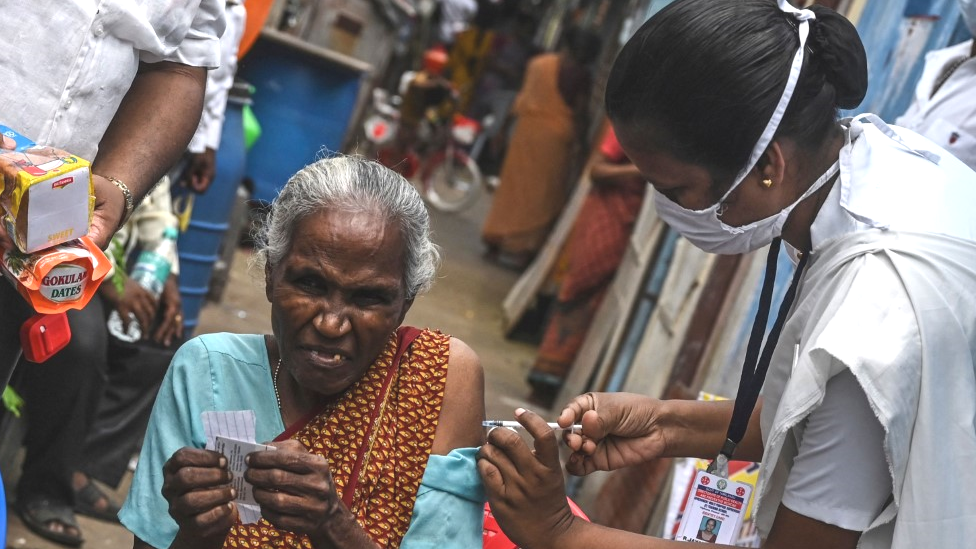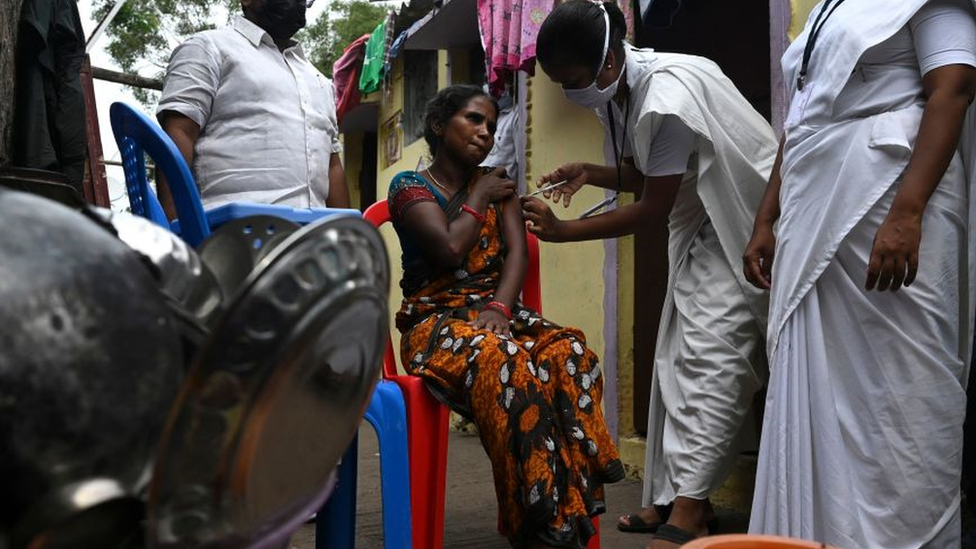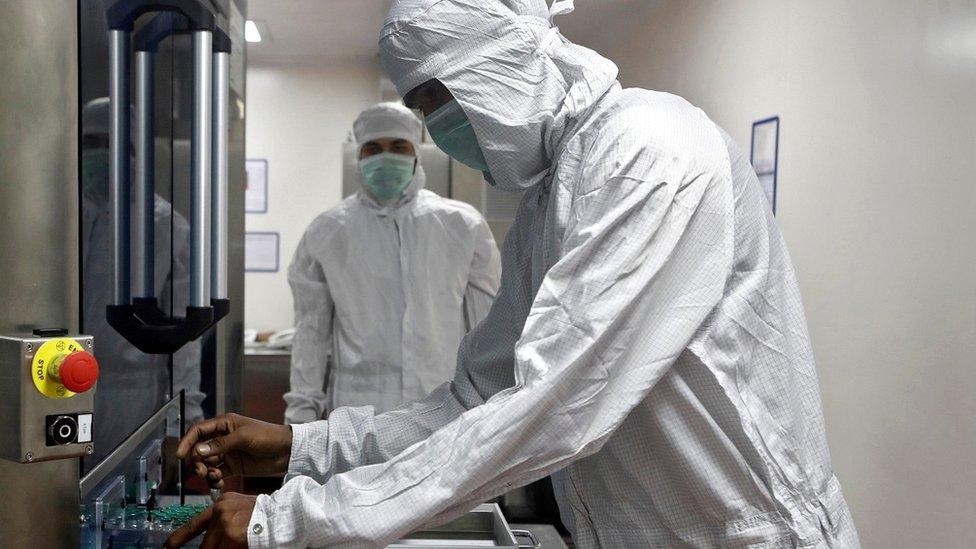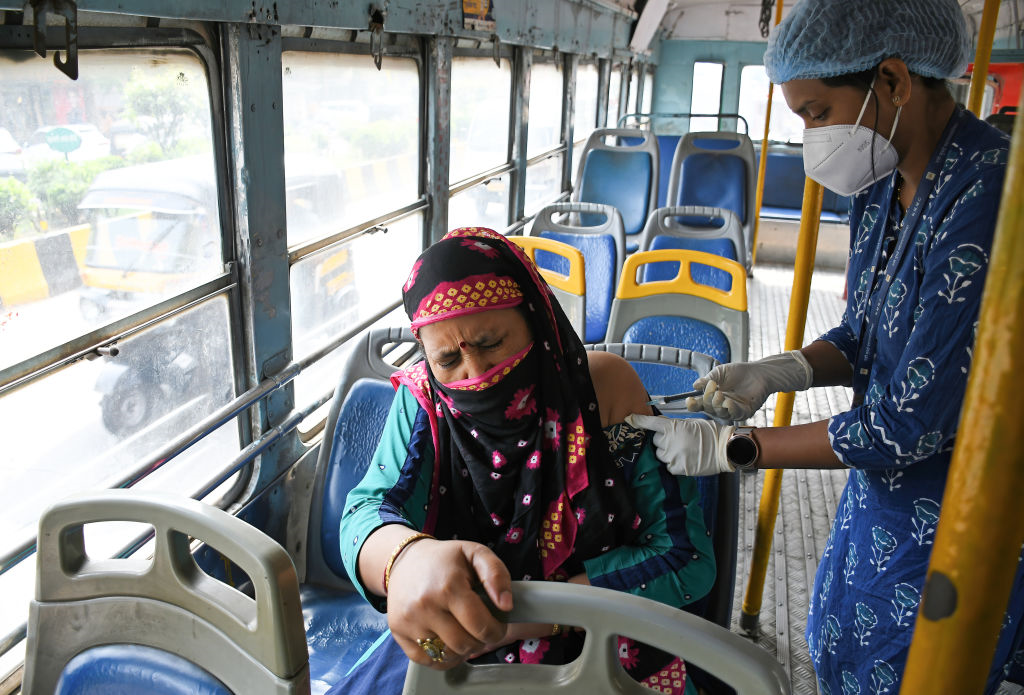Covid-19: How India missed its vaccination target
- Published

India has been conducting door-to-door vaccination campaigns
India has missed the target of giving its entire adult population of 940 million two vaccinations by the end of 2021.
The target was first announced by Prakash Javadekar in May, who was a minister in the federal government at the time.
"Vaccination in India will be completed by December 2021," he said.
How is the vaccine programme going?
As of 30 December, 64% of India's adult population was fully vaccinated and around 90% had received the first dose.
Experts said achieving full vaccination coverage would take a long time.
Dr Chandrakant Lahariya, an epidemiologist and health systems specialist, says the target set by the government was "unrealistic" because achieving 100% vaccine coverage at any given point would not be possible.
"There would always be some people who are unwilling to get vaccinated for various reasons," he said.
Weekly vaccinations have slowed since the first week of December, according to India's vaccine dashboard - CoWin., external

Since mid-October, more second doses have been given than first doses.
The daily vaccination numbers have been fluctuating with the highest number achieved on Prime Minister Narendra Modi's birthday on 17 September.
Over 20 million jabs were administered on that day, but the country has not been able to achieve the same number since.
The monthly average for September was around 8.1 million doses a day, but fell to 5.4 million in October and was 5.7 million in November.
Some experts say that if the September momentum had been kept up, India could have been closer to the target, but that demand would eventually have fallen.
The vaccination drive, which started in January, faced challenges such as supply constraints due to raw materials shortages, logistical issues and vaccine hesitancy.
By the second half of the year, the supply constraints had been addressed.
The challenge is now demand rather than the supply. "The vaccination drive has slowed down now because people are hesitant to take the vaccine," says Dr Lahariya.
On 3 November, the government launched a programme to conduct at-home inoculations.

A door-to-door campaign in Tamil Nadu state
A month after the programme was announced, first dose coverage had only increased by 6% and second dose coverage by 12%, external.
Mr Modi has now asked states to ramp up vaccinations in districts with low uptake amid fears about the spread of the more transmissible Omicron variant.
Over the past few months, the 100% target has not been mentioned in any of the press conferences by the health ministry.
We asked the ministry about missing the target, but did not hear back.
Does India have enough vaccines?
India is currently administering two locally-manufactured vaccines, Covishield and Covaxin, and the Russian vaccine, Sputnik.
India's largest vaccine maker, the Serum Institute of India (SII), was manufacturing 250 million doses of Covishield a month before the company announced production cuts in December due to a lack of orders.
It now produces between 125 and 150 million doses a month.
Bharat Biotech, the manufacturer of Covaxin, makes 50 to 60 million doses a month.
India's health minister, Mansukh Mandaviya, recently said in parliament that states had a stock of 170 million vaccines as of 20 December.
He added that vaccine manufacturing capacity would rise from the current 310 million doses a month to 450 million doses a month in the next two months.
This may include vaccines from other manufacturers. The junior minister of health, Dr Bharati Pawar, said: "Both companies [Bharat Biotech and SII] have achieved 90% of their production capacity."
The government has announced jabs for children aged 15 to 18 years and a booster programme for health workers and those above 60 years with other health conditions starting this month.
SII chief, Adar Poonawalla, said earlier this month that the company has 500 million vaccines in stock in case the government announces a booster programme.
The health ministry has said that around 6.2 million doses have been wasted since the start of the vaccine programme, which is considerably below the number that the World Health Organisation (WHO) would expect to be wasted, external.
There are other Indian-made vaccines expected to be used against Covid.

Vaccine production needs highly specialised raw materials
What other vaccines can India use?
Novavax, developed in the US and named Covavax in India, is being manufactured by SII - and has been granted emergency use listing by the WHO. It has also been granted approval by India.
SII has told the BBC that it is currently stockpiling these vaccine doses, and the capacities to manufacture this vaccine would be separate from Covishield.
Bharat Biotech has sought approval for trials of its intranasal vaccine as a booster shot.
Corbevax, manufactured by Biological-E, has also been granted approval in India.
India did give emergency use approval to the US-made Moderna vaccine in June, but so far no doses have been sent to India.
Johnson & Johnson's single dose vaccine was granted approval in August, but so far it hasn't been administered.
Supplies of foreign-made vaccines are facing legal hurdles over the manufacturers' desire for protection against potential claims arising out of using the vaccines - something no vaccine maker in India has at the moment.

A health worker administers Covid vaccine to a woman in a bus in Maharashtra
What about vaccine exports?
With vaccine demand in India slowing and daily cases falling, SII resumed exporting vaccines in November to Covax, the global vaccine-sharing programme.
Before exports were halted by India in April, Covax was reliant on supplies from SII to support the vaccine programmes in low and middle-income countries.
But exports have been slow and Covax has since relied on other vaccines.
Of the 700 million vaccines that have been delivered to 144 countries by Covax as of 14 December, around 40 million doses were provided by SII.
Around 28 million of those doses were supplied between January and April 2021, according to Covax.
